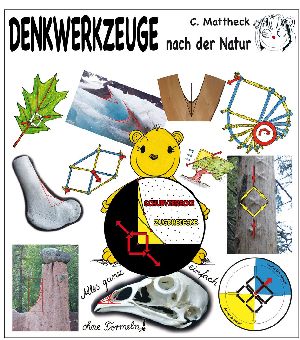A cliff line, the foot of a tree, a mammalian bone, washed-out areas of an iceberg, or the tree top sheared by wind can be described by the same contour as a torn-off scrap of paper. Three generally understandable thinking tools, shear quadran-gles, tension triangles, and force cones, are sufficient to analyze structures in nature and engineering without the use of a computer and to prevent component damage by simple shape optimization. The new book “Denkwerkzeuge nach der Natur” (thinking tools modeled on nature) by Claus Mattheck presents these thinking tools in an understandable manner and provides an introduction to “geometrical natural science.”
Who would have expected that the contour of a cliff line, the foot of a tree, a mammalian bone, washed-out areas of an iceberg or the tree top sheared by the wind can be described by the same contour as a torn-off scrap of paper? Who would have imagined that the rump of a water beetle fits exactly into a scaled-down crutch?
“The secret of these common geometrical features lies in a universal shape that occurs in nature over and over again,” explains Professor Dr. Claus Mattheck, Head of the Biomechanics Division of the Institute for Materials Research of Karlsruhe Institute of Technology (KIT). “It is exciting that this shape can be constructed with simple geometrical methods and applied immediately.”
The KIT Biomechanics Division developed three related thinking tools – shear quadrangles, tension triangles, and force cones – that allow for an analysis of mechanical structures in nature and engi-neering without any computer and, hence, prevent component dam-age by simple shape optimization.
A screw thread having this universal shape has a much longer de-fect-free service life. Industry already uses Matthecks universal shapes to optimize components within seconds by a CAD mouse click, whereas computer methods developed earlier by the team of Claus Mattheck needed several hours or even days. In tree hus-bandry and diagnosis, this universal shape explains the safety be-havior of trees in a way that was unimaginable in the past. The new thinking tools also help to identify the causes of damage. An angular crack in the corner of a room immediately tells which wall subsides relatively to the other. The new method can also be used in bone surgery and orthopedics. The universal shape can be found in many bone contours.
The new book “Denkwerkzeuge nach der Natur” (thinking tools modeled on nature) by Professor Dr. Claus Mattheck presents these thinking tools in an understandable manner and provides an intro-duction to a “geometrical natural science” demonstrating common geometrical features in their natural variety. As this new instruction book for thinking on the basis of nature does not contain any formulas and mechanics is conveyed by means of language and Mattheck’s characteristic science cartoons only, everybody, the pupil, arborist or craftsman, the architect and designer, the development engineer, physician, and the professor, is addressed.
The book (236 pages, ISBN 978-3-923704-73-6) by Claus Mattheck, Karlsruhe Institute of Technology, has just been published and may be purchased from the Buchhandlung Hoser & Mende KG, Karlsruhe (phone: +49 721 981610, fax: +49 721 815343, E-mail:mende ∂does-not-exist.schweitzer-online de) or from www.fabibook.de at a price of EUR 35.
Representatives of the media may contact Inge Arnold (phone: +49 7247 82-2861, E-mail:inge arnold ∂does-not-exist.kit edu) for a reviewer’s copy.
In close partnership with society, KIT develops solutions for urgent challenges – from climate change, energy transition and sustainable use of natural resources to artificial intelligence, sovereignty and an aging population. As The University in the Helmholtz Association, KIT unites scientific excellence from insight to application-driven research under one roof – and is thus in a unique position to drive this transformation. As a University of Excellence, KIT offers its more than 10,000 employees and 22,800 students outstanding opportunities to shape a sustainable and resilient future. KIT – Science for Impact.

